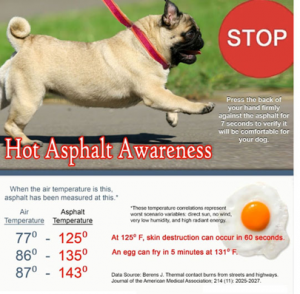 Summer can be a wonderful time for your pet: plenty of extra walks, the opportunity to explore the outdoors or lounge on a sunny spot, and maybe even a chance to go camping or getting extra time at the local dog park.
Summer can be a wonderful time for your pet: plenty of extra walks, the opportunity to explore the outdoors or lounge on a sunny spot, and maybe even a chance to go camping or getting extra time at the local dog park.
But with the warmer weather comes some unexpected dangers, and good reason to have a 24 hour vet on speed dial. From overheating through asphalt burns to a higher risk of falls and injuries, summer can be a dangerous time if you’re not prepared.
These pet tips will help you avoid some of the major risks:
Risk #1: High-Rise Syndrome
High-rise syndrome refers to the danger of pets (especially curious cats) falling from open windows, fire escapes or balconies. While you probably think of cats as animals with great balance, the truth is that accidents do happen – especially if your pet gets distracted by a nearby bird or squirrel. As you can imagine, the warmer weather means open windows and doors, which helps to make these accidents a common threat to pet summer safety.
The solution? Install screens in all your windows. Baby gates and sliding windows are not always enough unless they can be locked securely to keep your pet indoors.
Risk #2: Asphalt Burns
Taking doggie for extra-long walks now that the weather cooperates? Cool animals are happy animals, so always check the outside temperature before going on a walk. Asphalt heats up very quickly and stays hot for a while, even after the sun goes down.
If you can’t avoid walking on streets and sidewalks, make a trip on your own first. Check the temperature of the ground using the back of your hand or by stepping on it barefoot. Hold your hand down for a minimum of 7 seconds. If it’s too hot for you, it’ll be even hotter for your pup. And be aware that after swimming, paw pads will soften and can burn even faster than normal.
Risk #3: Overheating
Hot weather means a higher chance of overheating, especially if you’re spending long periods of time outdoors. Shade alone might not be enough to prevent overheating (especially if it’s humid) but it’s a good start. Whether you’re going for a walk or just spending time in the yard, watch out for signs of heatstroke and make sure there are shady areas where your pet can seek refuge if he (or she) needs to.
Plenty of cool water and even some frozen treats – like ice cubes or frozen green beans – are also a must.
If you have a pet with long hair, grooming can be another way to help him battle the heat. Just keep in mind that very short hair exposes the skin and could increase the chances of sunburn, especially in pets with a light coat. If you’re not sure how short to go, talk to your groomer or your vet to figure out the best options.
Risk #4: Insect Bites
Aside from the obvious dangers summer brings along, there’s another most people often ignore: insects. Mosquitoes are not only a nuisance, but they can also transmit a number of diseases. For example, mosquitoes can transmit heartworm, and the bite of ticks and fleas can lead to blood parasites, anemia, tapeworm and more. Animal-safe bug repellants are available through your vet and some pet stores. Never use human products on pets, as they can be highly toxic.
Watch this space for more pet summer safety tips to help you keep your furbabies happy and healthy throughout the season!

